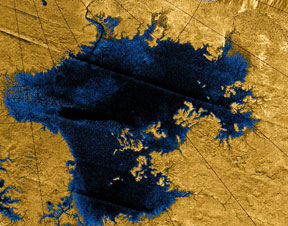This picture shows Ligeia Mare, one of the ethane and/or methane "seas" on Titan. This picture was made with radar data from the Cassini spacecraft. The colors in the picture have been added. Blue areas are liquid ethane/methane, while brown areas are "dry land". This sea is near Titan's North Pole. It is slightly larger (in area) than Lake Superior on Earth.
Click on image for full size
Image courtesy of NASA/JPL/USGS.
The Poles of Titan
Titan is the largest moon of Saturn. It is the second largest moon in the whole Solar System. Titan is the only moon with a thick atmosphere. Titan's poles are interesting places. Scientists have discovered lakes at both of Titan's poles. They also found small seas near the North Pole. They have also spotted clouds near each of the poles.
Titan is very cold. The surface temperature is around -179° C (-290° F). At that temperature water ice is as hard as rock. There is lots of methane and ethane on Titan. On Earth, methane is a gas. Many people use methane, also called natural gas, as a fuel in their home furnaces. On Titan, the cold temperatures turn methane and ethane into liquids. Titan's lakes and seas are filled with liquid ethane and methane instead of water. They are the first stable bodies of surface liquid found beyond Earth.
There are hundreds of lakes near Titan's North Pole. There are some that are so big that scientists are calling them seas. One sea (named Ligeia Mare) is about the size of North America's Lake Superior. There also lakes near the South Pole, though not as many.
So where did the liquid ethane and/or methane in the lakes and seas come from? Astronomers have spotted clouds over both of Titan's poles. One cloud over the North Pole was really, really big - about half as large as the United States. Maybe methane or ethane rain or snow falls from those clouds to Titan's surface, filling the lakes.
You might also be interested in:
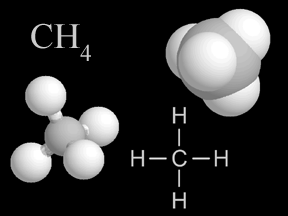
Methane is a kind of gas. There is a small amount of methane in the air you breathe. A methane molecule has carbon and hydrogen atoms in it. Methane is a greenhouse gas. That means it helps make Earth
...more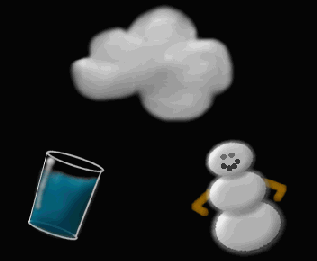
A snowman, glass of water and steam might look very different but they are made of the same stuff! Just like any substance, water can exist in three different forms, called states: solid, liquid and gas.
...more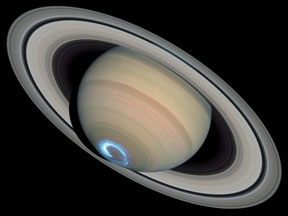
There's a lot of strange and interesting stuff going on at both the North and South Poles of Saturn. Two of Saturn's moons also have interesting polar regions. Let's take a look! The atmosphere and clouds
...more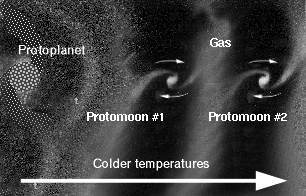
Titan is similar to the other icy moons, but Titan is the only icy moon to have a big atmosphere. It is natural to ask how is this possible? The nebula was colder near Saturn, than near Jupiter. The nebula
...more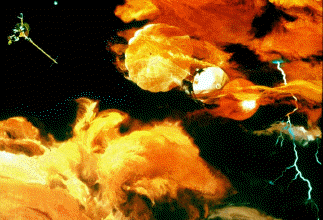
Titan's atmosphere is a lot like the Earth's, except that it is very cold, from -330 degrees to -290 degrees! Like the Earth, there is a lot of Nitrogen and other complex molecules. There also may be an
...more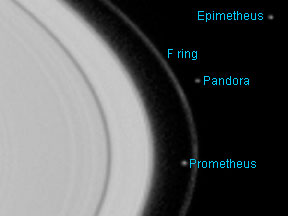
Pandora is a small moon of Saturn. It was discovered by S. Collins and others in 1980 from photos taken by the Voyager 1 spacecraft. Pandora's name comes from Greek mythology. Pandora was the first woman,
...more
Prometheus is a small moon of Saturn. It was discovered by S. Collins and others in 1980 from photos taken by the Voyager 1 spacecraft. This moon's name comes from Greek mythology. Prometheus was a Titan
...more


